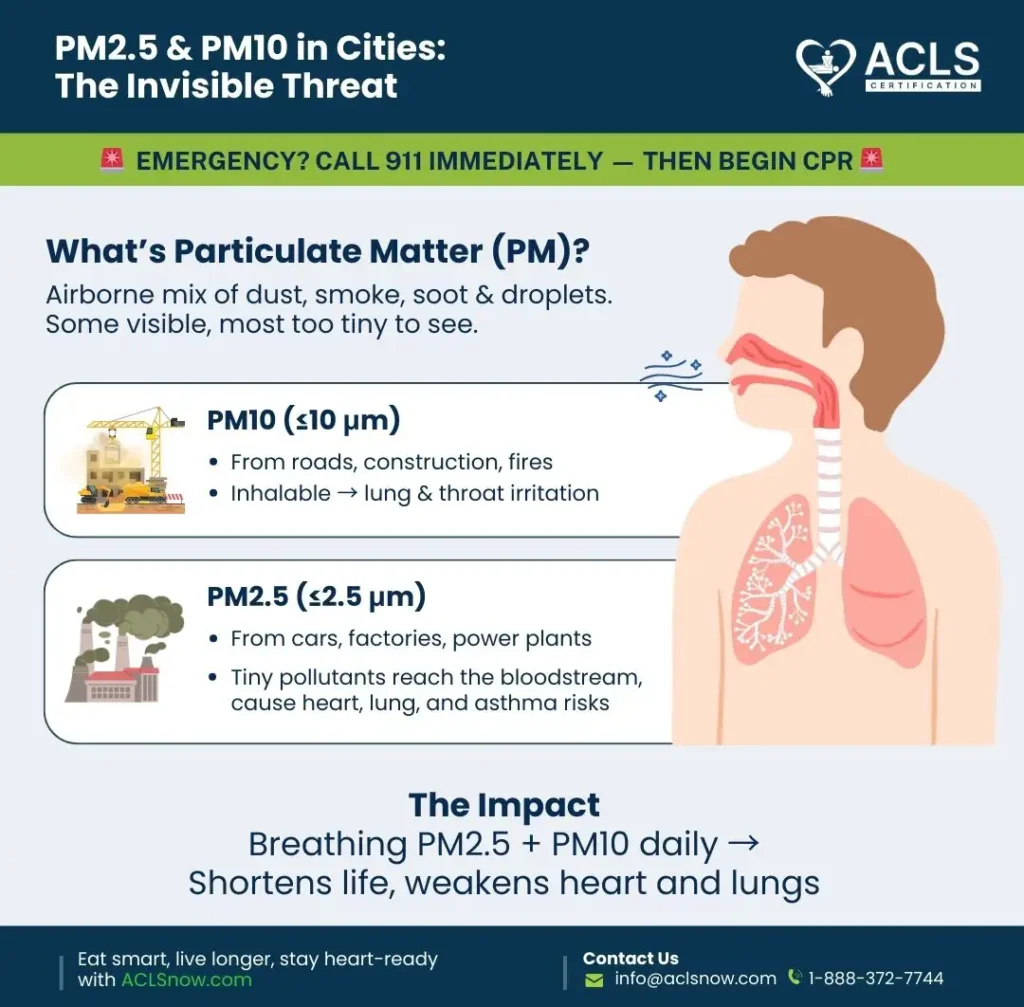Millions of people worldwide are affected by air pollution, which is a growing concern. Polluted air causes various health conditions around the world as industrialization, urbanization, and automobile emissions have increased. Air pollution has been found to have adverse effects on the lungs, but its effects on heart health are even more concerning.
Long-term exposure to air pollution is linked to an increased risk of heart disease, heart attacks, and other cardiovascular issues. In urban regions, the link between air pollution and heart disease has grown to be an important threat to public health.
In this article, we will discuss the numerous effects of pollution on the heart, look at the underlying mechanisms, and offer helpful preventative measures.
What Is Air Pollution?
Air pollution is the presence of toxic substances in the environment, such as particulate matter, NO₂, SO₂, CO, and ozone (O₃). These pollutants are produced by a number of sources, including power plants, vehicles, industry, agriculture, and the combustion of fossil fuels. The most hazardous among all pollutants is fine particulate matter (PM2.5).
What Is the Role of PM2.5 and PM10 in Urban Environments?
What’s Particulate Matter (PM)?
Airborne mix of dust, smoke, soot & droplets. Some visible, most too tiny to see.
🔹 PM10 (≤10 μm)
- From roads, construction, fires
- Inhalable → lung & throat irritation
🔹 PM2.5 (≤2.5 μm)
- From cars, factories, power plants
- Tiny pollutants reach the bloodstream, cause heart, lung, and asthma risks
The Impact
Breathing PM2.5 + PM10 daily → Shortens life, weakens heart and lungs
Protect your heart, start at ACLSnow.com
PM, often known as particulate matter, refers to an airborne mixture of solid particles and liquid droplets. Some particles, including smoke, soot, dust, or dirt, are big enough or dark enough to be seen with the naked eye. Others are so small that only an electron microscope can identify them.
PM2.5 and PM10 are the two types of particle pollution. PM10 particles have, on average, a diameter of 10 micrometers or less and are inhalable. PM2.5 are tiny, inhalable particles that usually have a diameter of 2.5 micrometers or less.
These particles can be composed of hundreds of different compounds and exist in a wide variety of sizes and shapes. Some are released directly from the source, like fields, smokestacks, fires, unpaved roads, and construction sites. Most of the particles in the atmosphere are formed by complex chemical reactions involving pollutants like sulfur dioxide and nitrogen oxides. Factories, power plants, and automobiles generate them.
Read more about: Cardiac Massage: Techniques and Importance in CPR Training
What Are the WHO Air Quality Guidelines?
The World Health Organization’s (WHO) Air Quality Guidelines (AQG) represent a global goal for national, regional, and city governments. It works toward improving citizens’ health by aiming to reduce air pollution and assess how heart disease is affected by air quality. The WHO air quality guidelines are a set of evidence-based advice for limit values for certain air pollutants. This will help countries achieve public health-protecting air quality. The WHO air quality standards were updated in 2021 in response to the ongoing threat that air pollution poses to public health.
PM, O3, NO2, and SO2 are among the common air pollutants for which the WHO air quality recommendations set limits and interim targets.
| Pollutant | Averaging Time | 2021 AQGs |
| PM2.5, μg/m3 | Annual | 5 |
| 24 Hoursa | 15 | |
| PM10, μg/m3 | Annual | 15 |
| 24 Hoursa | 45 | |
| O3, μg/m3 | Peak Seasonb | 60 |
| 24 Hoursa | 100 | |
| NO2, μg/m3 | Annual | 10 |
| 24 Hoursa | 25 | |
| SO2, μg/m3 | 24 Hoursa | 40 |
| CO, μg/m3 | 24 Hoursa | 4 |
- μg: microgram
- a: 99th percentile, or three to four exceedance days annually.
- b: The greatest six-month running average O3 concentration over six months, measured as the daily maximum 8-hour mean O3 concentration.
Note: While 24- and 8-hour exposures are short-term, annual and peak season exposures are long-term.
What Is the Impact of Polluted Air on Heart Health?
Air pollution doesn’t just affect your lungs; it also poses a serious threat to your heart. Numerous particles in polluted air are so small that they can eventually enter the heart and other parts of the circulatory system when inhaled. They increase the risk of various heart issues, such as heart attacks, strokes, and cardiac arrhythmia or abnormal heartbeats. This occurs through multiple mechanisms:
1. Inflammation
Polluted air contains fine particulate matter (PM2.5) and gases like ozone and nitrogen dioxide (NO₂), can penetrate deep into the lungs and enter the bloodstream. When these particles enter the body, they lead to chronic inflammation, one of the major factors in the development of cardiovascular diseases. This causes inflammation, which damages the blood vessels, as the body’s immune system reacts to the foreign particles.
2. Oxidative Stress
Long-term exposure to particulate matter may also lead to oxidative stress, which is another major factor in heart disease development. Oxidative stress in your body occurs when the free radicals, as well as antioxidants, become imbalanced. Free radicals, which are produced by air pollution, harm blood vessel linings, leading to endothelial dysfunction. Because of this dysfunction, blood vessels are unable to dilate and constrict, which raises blood pressure and puts more strain on the heart.
2. Increased Blood Pressure
One of the main risk factors for heart disease is high blood pressure, or hypertension, and there is an important connection between exposure to air pollution and increased blood pressure. Additionally, it has been discovered that pollutants like NO₂ and particulate matter (PM2.5) cause the release of stress hormones like cortisol, which raise blood pressure and heart rate. Because of this, ongoing high blood pressure damages the heart and blood arteries, making heart attacks, heart failure, and strokes more probable.
3. Autonomic Nervous System Disruption
Air pollution can interfere with the autonomic nervous system (ANS), which controls automatic functions like digestion, blood pressure, and heart rate. The ANS has two main branches:
- Parasympathetic system– supports rest and digestion.
- Sympathetic system – prepares the body for fight or flight.
Exposure to air pollution can disrupt the balance between these two systems. This imbalance may therefore raise the chances of sudden cardiac problems and result in arrhythmias, or irregular heartbeats.
4. Formation of Blood Clots
Blood clot formation has been associated with air pollution, especially fine particulate matter. According to a study, higher exposure to long-term air pollution has been related to an increased chance of blood clots in deep veins, which, if left untreated, may block blood flow and cause serious problems, including death. These findings were based on a longitudinal study funded by the National Institutes of Health (NIH) that monitored 6,651 people in the United States for an average of 17 years from 2000 to 2018.
Learn more about: Learn About the System of Care ACLS Guide in 2025
How Do Global Statistics Link Air Pollution and Heart Health?
The fact that millions of people suffer from and die due to cardiovascular disease due to air pollution brought on by prolonged exposure to contaminated air makes it an urgent threat to global health. Actually, the two main causes of death linked to air pollution worldwide are stroke and ischemic heart disease, which includes heart attacks. There is a clear link between air pollution and cardiovascular disease, according to numerous studies:
- The Harvard Six Cities Study: This long-term study discovered a correlation between higher particulate matter levels and greater mortality and heart disease rates.
- WHO Report 2021: The World Health Organization (WHO) estimates that outdoor air pollution causes 4.2 million premature deaths annually, with heart disease and stroke mainly due to fine particulate matter (PM2.5).
- The World Heart Federation (WHF) 2024: According to the WHF report, air pollution causes about 7 million worldwide cardiac deaths annually.
What Are the Preventive Strategies to Protect Your Health?
While it is hard to eliminate air pollution causing heart disease completely, there are numerous techniques for reducing its impact on your heart health. These are as follows:
-
Air Pollution Regulation
Governments play a vital role in protecting public health by enforcing stricter regulations to reduce pollution from power plants, automobiles, and factories. Additionally, they need to promote the use of renewable and clean energy sources to reduce pollution.
-
Green Spaces and Urban Planning
Cities can reduce pollution by designing infrastructure that limits car dependency. This includes expanding public transportation, promoting cycling and walking, and integrating more parks and green zones. Studies have shown that living in places with greater amounts of green space has been linked to a lower incidence of CVD.
-
Public Awareness
Raising awareness is key. Individuals can learn about the risks of air pollution and its impact on the heart through health initiatives and actionable tips. People should, for example, use high-efficiency particulate air (HEPA) air purifiers at home, wear masks when necessary, and stay indoors during periods of high pollution.
-
Health Monitoring
Studying and tracking the effects of air quality on heart disease over time is equally important. Governments should invest in nationwide air quality surveillance systems and integrate heart health data to identify populations at risk and respond quickly to environmental changes.
-
Personal Protective Measures
Lastly, everyone should be aware of the quality of the air in their area and take precautions to keep themselves safe. This involves using air purifiers indoors, wearing masks when necessary, and avoiding outdoor activities when pollution levels are high.
Adopt a Heart-Healthy Lifestyle to Avoid Heart Risks!
Long-term exposure to polluted air is a major and growing cause of cardiac issues around the world. Furthermore, air pollution affects the heart in a number of ways. It can elevate blood pressure, create inner body swelling, disrupt the body’s normal control, and make blood clots more prevalent. Therefore, it is essential to work on cleaning up the air, particularly in areas with the highest pollution levels.
Many groups must cooperate to protect heart health from air pollution. However, if an individual experiences a sudden cardiac emergency due to long-term exposure to polluted air, ACLS skills may come to the rescue. ACLS training focuses on quick recognition and intervention, such as high-quality CPR, defibrillation, and medication administration. Enroll today to get equipped with essential life-saving skills.








